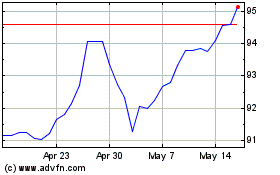Commodity Currencies Drop
July 23 2024 - 10:38PM
RTTF2
The commodity currencies such as Australia, the New Zealand and
the Canadian dollars weakened against other major currencies in the
Asian session on Wednesday, due to a sharp drop in commodity
prices.
Crude oil prices fell to near seven-week lows as investors brace
for a likely drop in demand. West Texas Intermediate Crude oil
futures for September ended down $1.44 or 1.83 percent at $76.96 a
barrel, the lowest settlement since June 7.
Asian stock markets traded lower, following the negative cues
from Wall Street overnight, as traders remain uncertain about the
outlook for the markets following recent volatility. They also
remain reluctant to make significant moves ahead of the release of
key U.S GDP and inflation data later in the week, which could have
a significant impact on the outlook for interest rates.
Weakness in iron ore miners and energy stocks also dampened
investor sentiment.
Australia's weak business activity data also led to the downturn
of the currency.
In economic news, the manufacturing sector in Australia
continued to contract in July, albeit at a slower rate, the latest
survey from Judo Bank revealed on Wednesday with a manufacturing
PMI score of 47.4. That's up from 47.2 in June, although it remains
beneath the boom-or-bust line of 50 that separates expansion from
contraction. The report also showed that the services PMI dipped to
50.8 from 51.2 in June. The composite index fell to 50.2 from 50.7
in June.
In the Asian trading today, the Australian dollar fell to near
3-month lows of 1.6473 against the euro and 101.67 against the yen,
from yesterday's closing quotes of 1.6410 and 102.99, respectively.
If the aussie extends its downtrend, it is likely to find support
around 1.65 against the euro and 101.00 against the yen.
Against the U.S. and the Canadian dollars, the aussie slipped to
a 1-1/2-month low of 0.6583 and a 4-week low of 0.9084 from
Tuesday's closing quotes of 0.6612 and 0.9115, respectively. The
aussie may test support near 0.64 against the greenback and 0.89
against the loonie.
The NZ dollar fell to nearly a 1-year low of 1.8338 against the
euro and a 1-week low of 1.1137 against the Australian dollar, from
yesterday's closing quotes of 1.8228 and 1.1109, respectively. If
the kiwi extends its downtrend, it is likely to find support around
1.84 against the euro and 1.12 against the aussie.
Against the U.S. dollar and the yen, the kiwi slid to near
3-month lows of 0.5914 and 91.41 from Tuesday's closing quotes of
0.5953 and 92.71, respectively. On the downside, 0.58 against the
greenback and 90.00 against the yen are seen as the next support
levels for the kiwi.
The Canadian dollar fell to more than a 3-month low of 1.3800
against the U.S. dollar and nearly a 3-month low of 111.91 against
the yen, from yesterday's closing quotes of 1.3786 and 112.99,
respectively. If the loonie extends its downtrend, it is likely to
find support around 1.39 against the greenback and 110.00 against
the yen.
Against the euro, the loonie edged down to 1.4970 from Tuesday's
closing value of 1.4957. The next possible downside support level
for the loonie is seen around the 1.51 region.
Looking ahead, PMI data from various European economies and U.K.
for July are due to be released in the European session.
In the New York session, U.S. MBA mortgage approvals data,
building permits for June, Goods trade balance for June, retail
inventories for June, new home saes data for June, U.S. S&P PMI
data for July, U.S. EIA crude oil data, Canada's new housing price
index for June, manufacturing sales data for June are slated for
release.
At 9:45 am ET, the Bank of Canada is set to announce its
monetary policy decision. The bank is expected to cut its overnight
rate by 25 bps to 4.5%.
NZD vs Yen (FX:NZDJPY)
Forex Chart
From Jun 2024 to Jul 2024

NZD vs Yen (FX:NZDJPY)
Forex Chart
From Jul 2023 to Jul 2024
